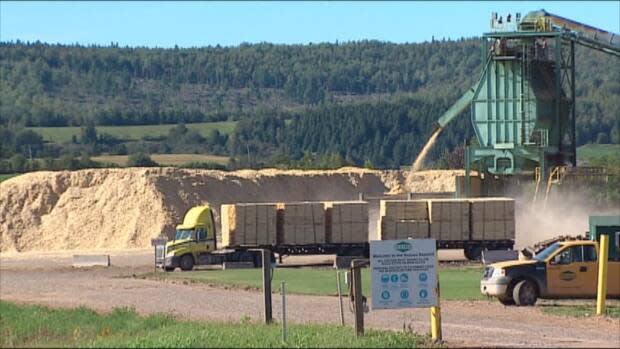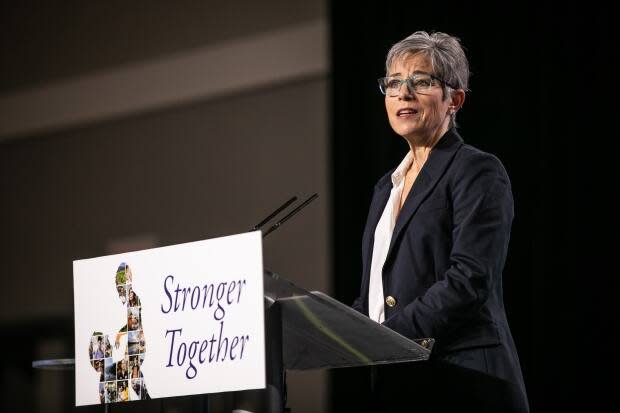New Brunswick forest companies using publicly owned trees to face higher charges

For the first time in nearly seven years, the New Brunswick government says it is preparing to increase what it charges forestry companies for their use of publicly owned trees.
Details are scarce, including the size of the increase being considered.
But in an interview Monday, Mike Holland, the minister of natural resources and energy development, said two years of elevated lumber prices convinced him royalty rates on Crown timber are not adequately compensating the province for what it supplies industry.
"We need to be able to move forward and put together systems that are good for all concerned and reflect where that [lumber] pricing winds up," Holland said.
"When lumber goes from 200 bucks per thousand board feet to 1600 bucks … we need to create some sort of a mechanism that reflects that, as far as it relates to the benefit to the province."

For the last two years, record lumber prices have been enriching New Brunswick forestry companies but have done little to raise revenues for those who supply the trees the lumber is made from.
Slightly more than half of the wood New Brunswick forestry companies use in their operations is owned by the province. The rest comes from a variety of sources, including industry's own forest holdings and thousands of smaller independent suppliers.
Earlier this month, Statistics Canada reported lumber production in March in New Brunswick was worth $180.7 million, a record for that month. That raised total lumber production for the fiscal year ended in March to $1.6 billion.
That amount is $700 million more than New Brunswick forest companies made from lumber in the 2020 fiscal year, but without paying any more in timber royalties to the province for the wood it used.
According to New Brunswick budget and public accounts documents, the province earned an estimated $70.3 million in royalties and fees on Crown trees in the 2020 fiscal year but $68.1 million in the year just ended in March. despite the increased earnings they made possible.

Holland said New Brunswick will not necessarily adopt royalty rates on Crown timber that change monthly or quarterly to match rising and falling lumber prices, the way some provinces do, but he acknowledged New Brunswick royalties have fallen out of step with current lumber prices.
"When a new normal is established, you know, our systems must reflect that," Holland said.
"I have never been a fan of chasing commodity pricing … but when we see prices move in a direction, when you get to a baseline you've got to catch up with that."
Current royalty rates on New Brunswick timber were set in July, 2015. In that year lumber prices in North America averaged $282 US per 1,000 board feet, well below the $883 US they averaged over the past year.

Last year in British Columbia, Canada's largest forestry province, Crown royalty rates were more than triple what they were in 2015, as the government made sure to share in the financial windfall. But in New Brunswick, rates never moved.
That has confounded observers of the province's forest industry, who don't understand why the province would not raise the price of its trees as lumber companies made more and more revenue from them.
It also frustrated those who sell their own trees to mills and who complained they could not get better prices while government charged so little.
"Everyone seems to be quite dumbfounded by the situation," Rick Doucet of the New Brunswick Federation of Woodlot Owners said last fall.
"You could collect that money, put it in the coffers of the province, and the mills themselves will still be doing quite well," Doucet said. "So there was an opportunity there to do something, and it's quite perplexing as to why they didn't move on it."

Holland said his department has been studying what to do about timber royalties for more than a year, but industry insiders do not appear to have been given much advance notice that a change is coming.
One of the largest sellers of trees in New Brunswick is Acadian Timber Corp. of Edmundston.
It is the second largest non-Crown owner of forest property in New Brunswick behind J.D. Irving and sells timber to mills for both pulp and lumber processing.
Two weeks ago, its president, Adam Sheparski, told investors on a conference call that the company has been pressing the province to charge more for its trees for some time but had not heard there was a plan to do that.
"There has been some quiet conversations ongoing," said Sheparski. "The continued pressure is there but nothing official as yet."
Lumber prices fell up to 35 per cent on futures markets last week, and although Holland acknowledged the province could have made more money from lumber pricing spikes over the last two years had it acted sooner, he said it took time to develop a comprehensive policy that will work in New Brunswick.
"I feel strongly that we did adopt the right approach," said Holland.
"We did exactly what we said we were going to do. Examine the tumultuous situation and come out the other end with something that's systematic."
Holland said details of the new plan are to be released within a month, he said.

